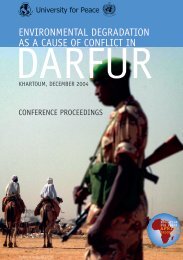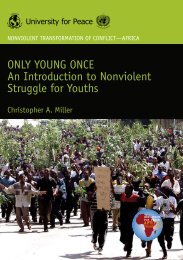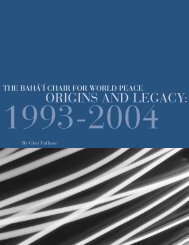who medicines strategy - libdoc.who.int - World Health Organization
who medicines strategy - libdoc.who.int - World Health Organization
who medicines strategy - libdoc.who.int - World Health Organization
Create successful ePaper yourself
Turn your PDF publications into a flip-book with our unique Google optimized e-Paper software.
HIGHLIGHTS | 3OUR VISIONOur vision is that people everywhere haveaccess to the essential <strong>medicines</strong> they need; thatthe <strong>medicines</strong> are safe, effective, and of goodquality; and that the <strong>medicines</strong> are prescribedand used rationally.EXPANDING ACCESS TO ESSENTIAL MEDICINESScaling up access to essential <strong>medicines</strong> —especially for HIV/AIDS, tuberculosis (TB), andmalaria — is critical to global efforts by WHO toprevent millions of deaths a year, reduce suffering,and help reduce the economic burden of illnesson the poorest families.WHO estimates that over 10.5 million lives ayear could be saved by 2015 — also boostingeconomic growth and social development — byexpanding access to existing <strong>int</strong>erventions forinfectious diseases, maternal and child health,and noncommunicable diseases.Most of these <strong>int</strong>erventions depend on essential<strong>medicines</strong>. Yet today, almost 2 billion people —one-third of the global population — do not haveregular access to essential <strong>medicines</strong>. In some ofthe lowest-income countries in Africa and Asia,more than half of the population have no regularaccess to essential <strong>medicines</strong>.In developing countries, where an estimated40 million people are infected with HIV/AIDS,life-saving antiretroviral <strong>medicines</strong> (ARVs) areavailable to only 300 000 of the 5-6 millionpeople currently in need of treatment — a crisisthat WHO has declared to be a global healthemergency.Average per capita spending on pharmaceuticalsin high-income countries is 100 times higherthan in low-income countries — about US$ 400compared with US$ 4. WHO estimates that 15%of the world’s population consumes over 90% ofthe world’s production of pharmaceuticals (byvalue).Access to health care is a fundamental humanright, enshrined in <strong>int</strong>ernational treaties andrecognized by governments throughout the world.However, without equitable access to essential<strong>medicines</strong> for priority diseases the fundamentalright to health cannot be fulfilled. Access toessential <strong>medicines</strong> is also one of the UN’sMillennium Development Goals (MDGs).Note:Numbered references (sources) are listed at the end (pages147-149). References indicated by a letter in the text areexplained in Endnotes (page 150).











